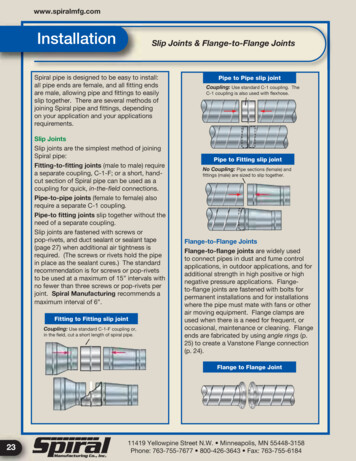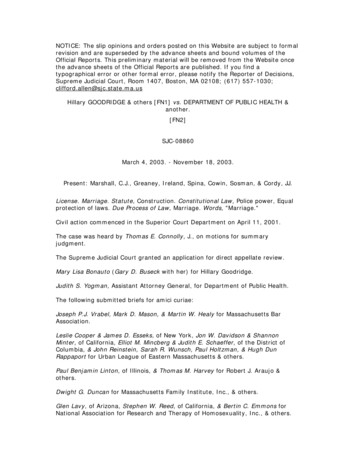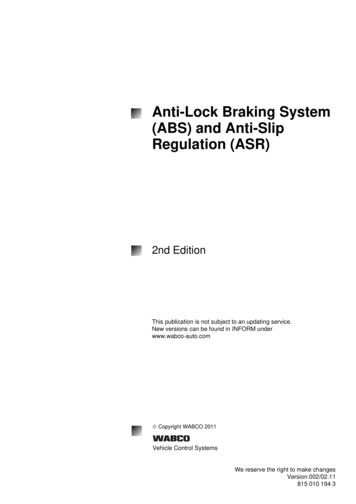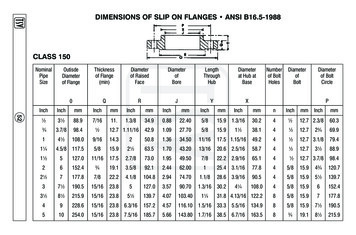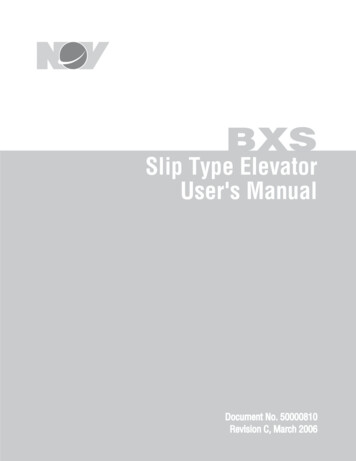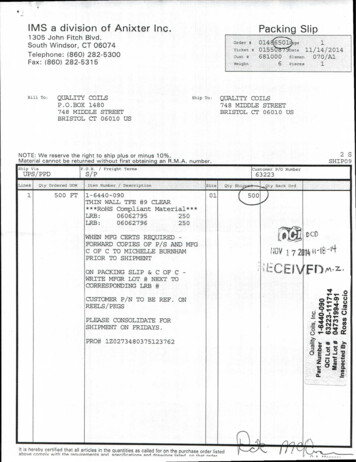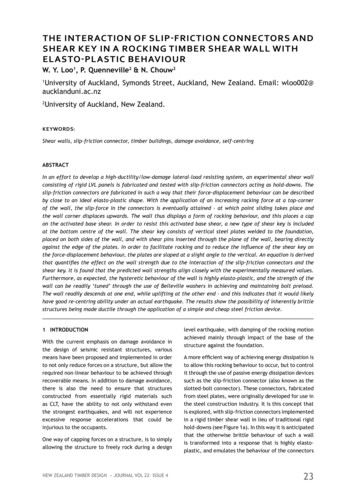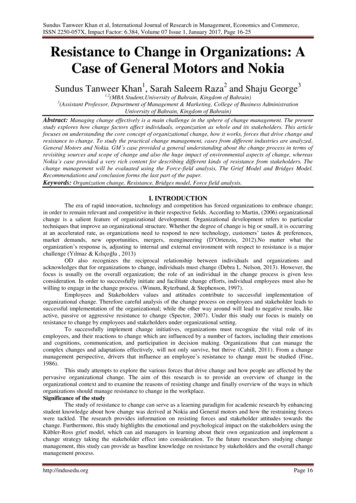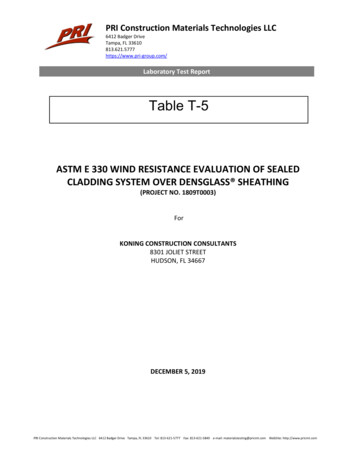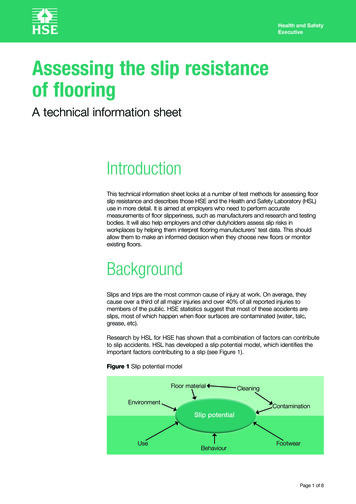
Transcription
Health and SafetyExecutiveAssessing the slip resistanceof flooringA technical information sheetIntroductionThis technical information sheet looks at a number of test methods for assessing floorslip resistance and describes those HSE and the Health and Safety Laboratory (HSL)use in more detail. It is aimed at employers who need to perform accuratemeasurements of floor slipperiness, such as manufacturers and research and testingbodies. It will also help employers and other dutyholders assess slip risks inworkplaces by helping them interpret flooring manufacturers’ test data. This shouldallow them to make an informed decision when they choose new floors or monitorexisting floors.BackgroundSlips and trips are the most common cause of injury at work. On average, theycause over a third of all major injuries and over 40% of all reported injuries tomembers of the public. HSE statistics suggest that most of these accidents areslips, most of which happen when floor surfaces are contaminated (water, talc,grease, etc).Research by HSL for HSE has shown that a combination of factors can contributeto slip accidents. HSL has developed a slip potential model, which identifies theimportant factors contributing to a slip (see Figure 1).Figure 1 Slip potential modelFloor materialEnvironmentCleaningContaminationSlip potentialUseBehaviourFootwearPage 1 of 8
Health and SafetyExecutiveThe information sheet describes methods of assessing the slipperiness of floors. Itaims to give employers enough information to select a method to test theslipperiness of the floor and interpret the results.Assessment of slipperiness:The HSE approachThe Workplace (Health, Safety and Welfare) Regulations 19921 require floors to besuitable, in good condition and free from obstructions. People must be able tomove around safely.Research carried out by HSL, in conjunction with the UK Slip Resistance Group(UKSRG) and the British Standards Institution, has shown that commerciallyavailable, portable scientific test instruments can accurately assess the slipperinessof flooring materials.HSL has developed a reliable and robust test method using these instruments toassess floor surface slipperiness. The method has been used as the basis of HSEand local authority advice and enforcement action.The methodology is based on using two instruments: a pendulum, used in the pendulum coefficient of friction (CoF) test (HSE’s preferred method of slipperiness assessment, see Figure 2);a surface microroughness meter (see Figure 3).Figure 2 The pendulum CoF testFigure 3 Surface microroughness meters(left to right: Mitutoyo Surftest SJ201P, Surtronic Duo and Surtronic 25)Assessing the slip resistance of flooringPage 2 of 8
Health and SafetyExecutiveThis methodology is ideally suited to both laboratory-based assessment, and foruse on installed floors.PendulumThe pendulum CoF test (also known as the portable skid resistance tester, theBritish pendulum, and the TRRL pendulum, see Figure 2) is the subject of a BritishStandard, BS 7976: Parts1-3, 2002.2The method is based on a swinging, imitation heel (using a standardised rubbersoling sample), which sweeps over a set area of flooring in a controlled manner. Theslipperiness of the flooring has a direct and measurable effect on the pendulum testvalue (PTV) given.The preparation of the standard rubber sliders is detailed in BS 7976: Parts1-3,2002 and the UKSRG guidelines.3 There is a small difference between the twomethods of slider preparation, and in certain limited situations the two methodsmay give slightly different results. HSE and the UKSRG believe the changes in thelatest version of the UKSRG guidelines (2011) give the most useful results.Research has confirmed the pendulum to be a reliable and accurate test, so HSE hasadopted it as its standard test method for assessing floor slipperiness in both dry andcontaminated conditions. However, to use it reliably, it needs to be operated andinterpreted by a suitably trained and competent person. For profiled floors, severaltests in different directions may be required to obtain a good understanding of profiledsurfaces. So, only an experienced operator should assess these types of floors.Interpretation of pendulum resultsPendulum results should be interpreted using the information reproduced in Table 1(from UKSRG, 2011).Table 1 Slip potential classification, based on pendulum test values (PTV)PTVHigh slip potential0-24Moderate slip potential25-35Low slip potential36 Practical considerationsUsing Slider 96 rubber gives enough information for assessing slipperiness for shodpedestrians. For assessing barefoot areas, use Slider 55 rubber and for profiledflooring it may be helpful to use both slider materials.Assessing the slip resistance of flooringPage 3 of 8
Health and SafetyExecutiveThe pendulum test equipment is large and heavy, so consider the manual handingof the equipment carefully for testing in the field.Surface microroughnessAn indication of slipperiness in water-contaminated conditions may be simply obtainedby measuring the surface roughness of flooring materials. Roughness measurementsmay also be used to monitor changes in floor surface characteristics, such as wear.Research has shown that measuring the Rz parameter allows slipperiness to bepredicted for a range of common materials. Rz is a measure of total surfaceroughness, calculated as the mean of several peak-to-valley measurements.Interpretation of surface roughnessWhen surface microroughness data is used to supplement pendulum test data, theroughness results should be interpreted using the information reproduced inTable 2 (from UKSRG, 2011). Where only roughness data is available, use it inconjunction with the Slips Assessment Tool (SAT) detailed below.Table 2 Slip potential classification, based on Rz microroughness values (applicablefor water-wet pedestrian areas)Rz surface roughnessSlip potentialBelow 10 µmHigh10-20 µmModerate20 µmLowPractical considerations:Roughness metersResearch has shown that the Rz roughness parameter gives a good indication offloor slipperiness in water-contaminated conditions. The measurement of Rz usinga hand-held meter is simple and quick. Roughness meters (see Figure 3) areunsuitable for use on carpet, undulating or very rough floors.The figures quoted in Table 2 relate to floor surface slipperiness in water-contaminatedconditions. If there are other contaminants, different levels of roughness will be neededto lower slip potential. As a general rule, a higher level of surface roughness is neededto maintain slip resistance with a more viscous (thicker) contaminant.Assessing the slip resistance of flooringPage 4 of 8
Health and SafetyExecutiveSlips assessment tool (SAT)HSE and HSL have produced a PC-based software package to help users to carryout a slip risk assessment of level pedestrian walkway surfaces. SAT prompts theuser to collect surface microroughness data from the test area, using a hand-heldmeter. SAT supplements the surface microroughness data (Rz) with other relevantinformation from the pedestrian slip potential model. This includes the causes offloor surface contamination, the regimes used to clean the floor surface (both interms of their effectiveness and frequency), footwear types worn in the area, alongwith associated human factors and environmental factors. On completion, SATsupplies a slip risk classification; this indicates the potential for a slip. SAT isdesigned to help in the decision-making process when considering the risk ofslipping in a defined area, and can be used iteratively to show the influence ofdifferent control measures. However, do not rely on it when considering theperformance of just the flooring; in this instance a suitable CoF test should be used.The SAT software can be downloaded free at www.hse.gov.uk/slips/sat/index.htm.The HSL ramp testThe HSL ramp test (Figure 4) is designed to simulate the conditions commonlyencountered in typical workplace slip accidents. This uses clean water as thecontaminant and footwear with a standardised soling material. Barefoot testing mayalso be undertaken. The test method involves using test subjects who walkforwards and backwards over a contaminated flooring sample. The inclination ofthe sample is increased gradually until the test subject slips. The average angle ofinclination at which slip occurs is used to calculate the CoF of the flooring. The CoFmeasured relates to the flooring used on a level surface. It is possible to assessbespoke combinations of footwear, flooring and contamination, relating to specificenvironments, using this method. HSL also uses the ramp to assess theslipperiness of footwear.Figure 4 The UKSRG ramp CoF testAssessing the slip resistance of flooringPage 5 of 8
Health and SafetyExecutiveOther ramp testsMany European flooring manufacturers use ramp-type tests to classify theslipperiness of their products before sale. Such tests are generally carried out usingGerman National Standard test methods (DIN 51097:19924 and DIN 51130:20045).DIN 51097 uses barefoot operators with a soap solution as the contaminant, andDIN 51130 uses heavily-cleated EN:ISO 20345 safety boots with motor oilcontamination. HSE has reservations about these test methods, as neither usescontaminants that are representative of those commonly found in workplaces andthe way the results are reported and applied (see below) is a cause for concern.Floor surface materials are often classified on the basis of the DIN standards. Theclassification schemes outlined in DIN 51130 (Table 3) and DIN 51097 (Table 4) haveled to some confusion, sometimes resulting in the wrong floor surfaces being installed.Table 3 DIN 51130 R-Value slipperiness classificationClassificationR9R10R11R12R13Slip angle (º)6-1010-1919-2727-35 35Table 4 DIN 51097 slipperiness classificationClassificationABCSlip angle (º)12-1718-23 24The R scale runs from R9 to R13, where R9 is slippery when wet, and R13 theleast slippery. Floor surfaces that are classified by the DIN 51130 standard as R9(or in some instances R10) will be slippery when used in wet or greasy conditions.Further problems may arise from the wide range of CoF within a given classification,for example R10 covers a CoF range from 0.18 to 0.34, which represents a verywide range of slip potential. Floor surfaces that are classified by the DIN 51097standard as A (and in many instances B) will be slippery when wet.Other testsThe instruments that have been dubbed ‘sled tests’ involve a self-powered trolleythat drags itself across the floor surface. These tests do not recreate the conditionsof pedestrian gait which give rise to most slip accidents. Data from such machinesis unlikely to be relevant to pedestrian slipping in contaminated conditions.The SlipAlert test6 involves a trolley rolling down a ramp and skidding across thefloor surface. The results show good agreement with the pendulum when aproperly prepared Slider 96 rubber is used. A large test area is required and as thetest slider travels a significant distance over the floor, it measures the average slipresistance of the area, so small areas of slippery floor may not be identified. Thedevice does give a good visual indication of changes in slip resistance, such asfrom dry to wet, and can be particularly useful for staff training around cleaning.Assessing the slip resistance of flooringPage 6 of 8
Health and SafetyExecutiveInterpretation ofmanufacturers’ dataMost slip resistance information provided by flooring manufacturers is producedfrom as-supplied products (ie ex-factory). The slipperiness of flooring materials canchange significantly due to the installation process, eg due to grouting, cleaning,burnishing or polishing; and after short periods of use. Inappropriate maintenanceor longer-term wear also change the slip resistance of flooring. Data quoted simplyas CoF should be viewed with uncertainty, as the type of CoF test used will criticallyaffect the validity of the data.The test data needed to characterise a floor should relate to the floor when finishedfor its intended use and with any contamination present in normal use.References and further readingReferences1 Workplace health, safety and welfare. Workplace (Health, Safety and Welfare)Regulations 1992. Approved Code of Practice L24 HSE Books 1992ISBN 978 0 7176 0413 5 www.hse.gov.uk/pubns/books/L24.htm2 BS 7976-1: 2002 Pendulum testers. Specification British StandardsInstitution 2002BS 7976-2: 2002 Pendulum testers. Method of operation British StandardsInstitution 2002BS 7976-3: 2002 Pendulum testers. Method of Calibration British StandardsInstitution 20023 The assessment of floor slip resistance Issue 4.0 United KingdomSlip Resistance Group 20114 DIN 51097: 1992 Testing of floor coverings; determination of the anti-slipproperties; wet-loaded barefoot areas; walking method; ramp test German NationalStandard 19925 DIN 51130: 2004 Testing of floor coverings; determination of the anti-slipproperties; workrooms and fields of activities with slip danger; walking method;ramp test German National Standard 20046 Evaluation of the Kirchberg Rolling Slider and SlipAlert Slip Resistance MetersAvailable at www.hse.gov.uk/research/hsl pdf/2006/hsl0665.pdfAssessing the slip resistance of flooringPage 7 of 8
Health and SafetyExecutiveFurther readingSafer surfaces to walk on, reducing the risk of slipping CIRIA C652 2006More information about slips and trips can be found at www.hse.gov.uk/slips.Further informationFor information about health and safety, or to report inconsistencies or inaccuraciesin this guidance, visit www.hse.gov.uk/. You can view HSE guidance online andorder priced publications from the website. HSE priced publications are alsoavailable from bookshops.British Standards can be obtained in PDF or hard copy formats from BSI:http://shop.bsigroup.com or by contacting BSI Customer Services for hard copiesonly Tel: 020 8996 9001 email: cservices@bsigroup.com.This document cont
Most slip resistance information provided by flooring manufacturers is produced from as-supplied products (ie ex-factory). The slipperiness of flooring materials can change significantly due to the installation process, eg due to grouting, cleaning, burnishing or polishing; and after short periods of use. Inappropriate maintenance or longer-term wear also change the slip resistance of flooring .File Size: 529KBPage Count: 8
